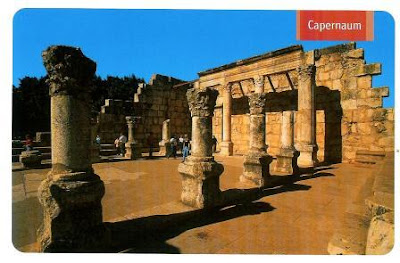Cards from Israel are a rare sight in my mailbox and I only have a few in my collection. Last week I got two sent by Debora. This one is from Capernaum, currently an archeological site known as the Town of Jesus.
Situated on the banks of the Sea of Galilee, the town of Capernaum remained a large (in ancient terms) and prominent city, holding some 1,500 residents, for over nine centuries until its mysterious evacuation in the 7th century AD.
Though no longer a functioning town, Capernaum's importance in modern times is based on its rich history in antiquity and its multiple mentioning in the New Testament. Most notably, Capernaum is believed to have been Jesus' home and the center of his ministry after leaving his birth town of Nazareth. Reference to Capernaum as Jesus' home and the place where He performed many of His miracles is made in the Gospel of Matthew, where it is said that Jesus was approached by a Roman officer who asked Him to heal his servant when the latter fell ill. Jesus' ability to cure the feverish servant serves, to this day, as a reminder of His ability to work miracles. In the Gospel of Luke too, the town of Capernaum is mentioned several times with regard to Jesus prophetic abilities. According to Luke, in the town of Capernaum Jesus healed a man who was possessed by the devil, as well as curing Peter's sickly mother in law.
Capernaum is mentioned twice more in the New Testament, once as the home of Peter, Andrew, James and John, as well as the dwelling place of Matthew the tax collector. The second time Capernaum is referred to is as one of the three cities damned by Jesus for its inhabitants' wrong doings and lack of faith in God.
For all its importance in Jesus' life and His ministry, Capernaum is a destination not to be missed when on a Christian tour to Israel.
© Published by Palphoto Ltd * Photography by S. Mendrea
Of particular interest in Capernaum are the ruins of the ancient synagogue. Though there is no finite knowledge of the time this synagogue was built, archeologist estimate that it dates back to the 1st century AD.
It was the Roman officer who asked Jesus to heal his servant that is credited with building the synagogue as a token of good faith and gratitude to Jesus for his miracle work. Liturgical documents indicate that Jesus held regular sermons in this synagogue, most notably the famed sermon on the Bread of Life (John 6: 35-59).
Of this ancient synagogue, only the western wall remained in tact. It has been the foundation for a later synagogue built on the same grounds some three centuries later.
The ruins seen in Capernaum today are of the later synagogue, which stands out from the rest, much humbler, huts and small stone houses in the city. With white bricks making up its external walls and intricately painted stucco covering its internal walls, the synagogue must have been quite lavish when in use. The excavations carried out by the Franciscans have also uncovered four distinctly separate halls, making the synagogue big enough to seat all the town's inhabitants. - in: http://www.tourstotheholyland.com/christian-travel-guide/places-in-the-holy-land/capernaum.aspx

No comments:
Post a Comment